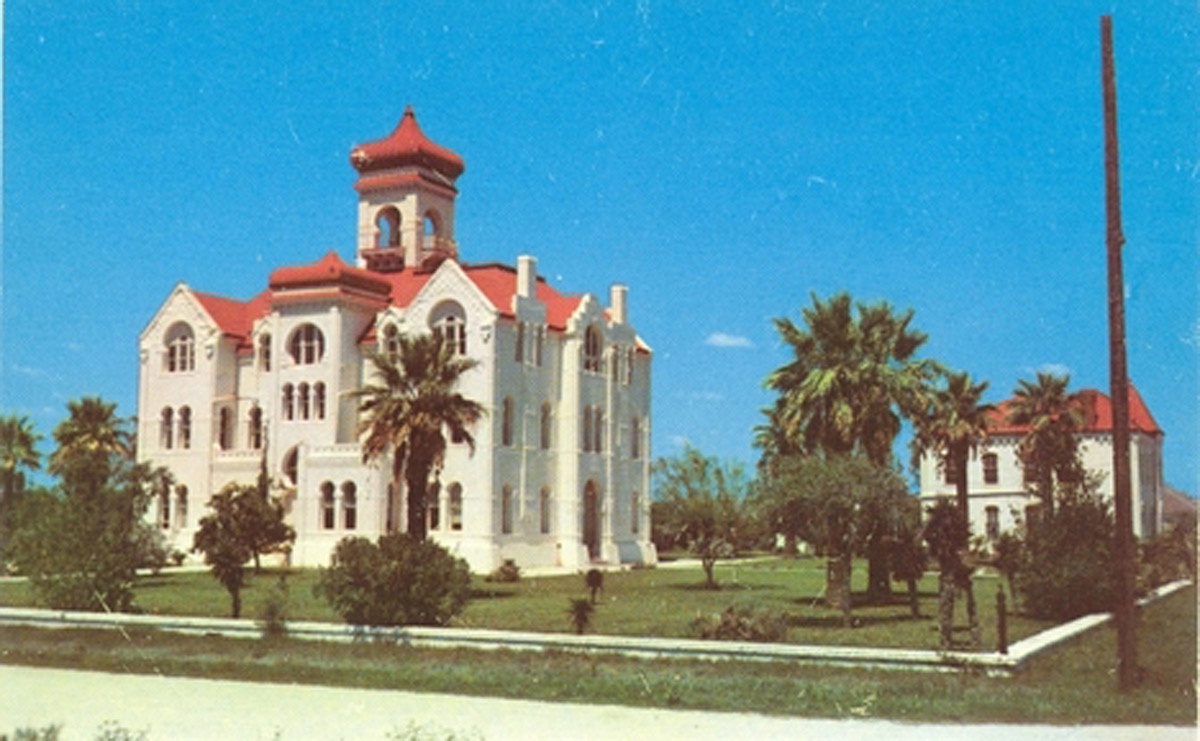Cramped and outdated, the 1892 Victoria County Courthouse faced demolition in 1961 to make way for a new building in downtown Victoria. When historical preservationists got wind of the plan, they rallied support and presented a 13-foot-long petition to county commissioners. Unfurling the scroll, they read aloud the names of 661 county residents who wanted the courthouse’s exterior to remain intact. Following this citizens’ directive, commissioners voted to make no outside changes to the three-story edifice, adorned with turrets, arched windows and a clock tower.
Today, the former Victoria County Courthouse houses county offices and stands among 12 surviving Texas courthouses designed and built by James Riely Gordon. From 1889 to 1902, the prolific architect designed 18 “temples of justice”—plus commercial, religious, residential and other civic buildings—across the state.
Ranked among Gordon’s outstanding work is the Ellis County Courthouse, heralded as a “masterpiece” by author James Michener. In his 1985 historical novel Texas, Michener likens the pink-and-gray granite building in Waxahachie to a “… fairy-tale palace 10 stories high, replete with battlements and turrets and spires and soaring clock towers and miniature castles high in the air. It was a bejeweled treasure, yet it was also a sturdy, massive court of judgments, one of the finest buildings in Texas.”

Web Extra: A postcard shows the James Riely Gordon-designed Ellis County Courthouse in Waxahachie.
Courthousehistory.com
Born August 2, 1863, in Winchester, Virginia, Gordon moved with his mother and civil engineer father to San Antonio in the early 1870s. He joined the civil engineer corps of the International-Great Northern Railroad at age 14. In 1881, Gordon worked under architect William K. Dobson and then as a draftsman with J.N. Preston & Son. In late 1884, he opened his own San Antonio office with established architect Frederick Shelton. In the coming years, Gordon would go in and out of partnerships and would also run an office in Dallas.
Gordon traveled the state by train and buggy in search of clients. “On these trips, he carried generic plans for a variety of structures that he adapted to the specific needs of anyone he could interest,” writes Chris Meister in James Riely Gordon: His Courthouses and Other Public Architecture. “A study of the architect’s known work finds most of his early structures in communities along rail lines connecting with San Antonio.”

Web Extra: A postcard shows the James Riely Gordon-designed Angelina County Courthouse in Lufkin. It has since been demolished.
courthousehistory.com
Gordon’s start as an architect couldn’t have had better timing. In 1881, the 17th Texas Legislature passed a bill that allowed counties to borrow funds to build public buildings. The earliest courthouses in Texas were tents, dugouts or simple log structures, according to The Courthouses of Texas, by Mavis P. Kelsey Sr. and Donald H. Dyal. Because these primitive affairs were often unsafe, the 1881 bill empowered county commissioners to build spacious, fireproof buildings that inspired awe and attracted commerce.
The golden age of grandiose Texas courthouses had begun.
In those days, counties often staged competitions to attract designs for courthouse projects. In 1888, Gordon entered an Aransas County contest in Rockport. His exotic Moorish concept, graced with horseshoe arches and onion domes, stood out among plans submitted by other architects, including the esteemed Alfred Giles and Otto Kramer. Gordon’s first courthouse served citizens for 65 years before it was torn down.

Web Extra: A postcard shows the James Riely Gordon-designed Aransas County Courthouse in Rockport. It has since been demolished.
Courthousehistory.com
Aside from their resplendent facades, Gordon’s courthouses had another major selling point: In broiling summer months, they felt cooler inside. To maximize comfort, the architect created a cross-shaped layout with a center atrium, a combined shaft and tower, and corner entrance porches. The plan, which Gordon copyrighted and improved with subsequent projects, worked like a chimney, drawing cool air from the porches while venting hot air upward through the tower. Eleven courthouses followed Gordon’s “Signature Plan,” according to a list in Meister’s book.
After the 1893 fair, Gordon continued his work in Texas, designing 13 more courthouses. Brazoria (demolished), Hopkins, Gonzales, San Patricio (demolished), Ellis, Van Zandt (demolished), Wise, Comal and Lee reflect his Richardsonian Romanesque style. With Harrison (now a museum), McLennan and Angelina (demolished), Gordon transitioned to the Beaux-Arts style that uses grand entrances and towering pillars. A low budget kept Callahan (demolished) sparse in architectural detail.
In June 1902, Gordon moved his practice and family to New York. Shortly before his 1937 death, he designed a building for the 1939 New York World’s Fair. The honor ended the 53-year career of the architect who signed his work J. Riely Gordon and got his start in Texas.
Sheryl Smith-Rodgers of Blanco blogs about her gardening adventures at sherylsmithrodgers.blogspot.com.












